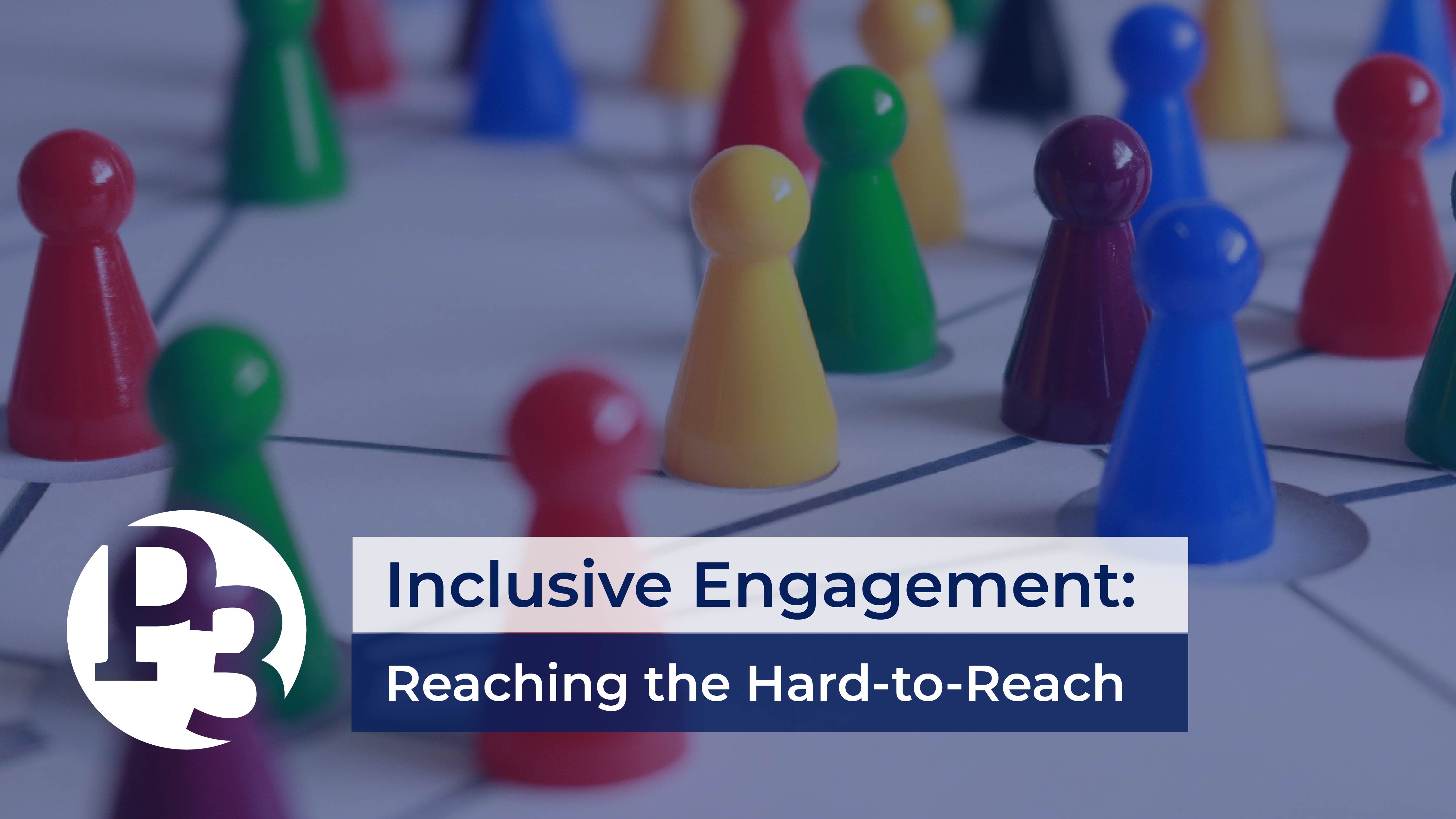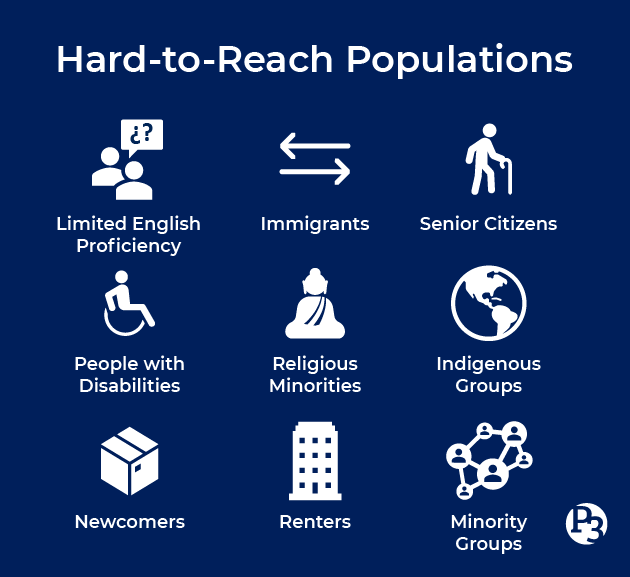
27 Aug Inclusive Engagement: Reaching the Hard-to-Reach
Agencies want to make decisions that best fit their goals while also keeping in mind the needs and concerns of the community, and this isn’t possible without public input. An effective public engagement process will reach all members of a community, informing them and empowering them to shape decision-making. However, agencies may find it challenging to reach all individuals within a community.
Without all perspectives, the input obtained is less representative and may not be the best guide for decision-making. Agencies therefore must make a conscious effort to reach the hard-to-reach populations within an area to ensure the data collected is representative of the diversity of the community.
Who are the Hard-To-Reach?
Hard-to-reach populations are those that are more difficult to contact and engage through traditional engagement methods. These groups may include people with limited English proficiency, immigrants, religious minorities, indigenous groups, senior citizens, people with disabilities, renters, new residents in a community, or those that are not a part of organized groups. Hard-to-reach groups may also include minority populations that are disproportionately affected by project impacts, and therefore hearing their perspectives is critical to minimize adverse impacts as much as possible.

Hard-to-reach groups may find it even more difficult to participate during the COVID-19 pandemic as engagement has shifted to be largely virtual. Face-to-face meetings have been infrequent or temporarily abandoned for the sake of public health and agencies have relied on digital communication with the public, such as virtual public meetings, email conversations, and online surveys.
Hard-to-reach populations may not have reliable access to the internet, may have limited English proficiency, or may not know how to receive the necessary information about what is happening in their community. All of these factors and more can contribute to them being at a disadvantage in a virtual public engagement process.
What are some ways to reach the hard-to-reach? Check out these tips for gathering representative data!
Seek out representatives of community groups.
Leaders of community groups can help agencies overcome the communication barrier of reaching the hard-to-reach. This is especially important during the COVID-19 pandemic, because it may be harder for agencies to get out there and engage these groups in person. However, if they gain assistance from these community representatives, they can act as communication liaisons between the agencies and hard-to-reach individuals, informing them of upcoming project milestones and where to find more information.
Finding community leaders and initiating contact is the first step, but it is also important to maintain a long-term relationship with the community leaders and groups as well. This allows them to remain involved throughout public participation processes and helps to establish trust through a mutually beneficial relationship.
Provide alternatives to electronic participation.
While digital public engagement is a great tool, especially during a pandemic, not all are able to participate this way. Some may not have the proper devices to access materials or they may not have reliable internet access. You’ve probably heard the saying that everyone has a smartphone nowadays, and it is estimated that 81% of Americans do. However, owning a smartphone does not guarantee access to the internet. 75% of Americans have access to broadband internet, but that means 1 in 4 people do not have reliable internet access or data capabilities. Additionally, internet access is disproportionate based on income, race, and age. Therefore, providing alternatives to digital participation allows for more members of the community to stay involved.
A good method is to provide hard-copies of all information that can be obtained electronically. While you do not need to send this out to every resident in the community, make it known that those materials are available upon request. Provide paper surveys, paper flyers, and paper handouts to those that prefer them. With paper surveys or any materials that need to be sent back after obtaining input, ensure that you include return postage so that the cost is not placed on the resident.
Provide easy access to translated materials.
Whether through digital or hard copies, ensure residents can access translated materials to receive necessary information. While this is helpful in all communities, it is critical in communities that meet the Low English Proficiency (LEP) threshold. This threshold exists when either 5% or 1,000 people within a study area have low proficiency.
Digital translated materials may be presented separately, such as via a different survey form for Spanish speakers. However, some agencies opt to provide translation services directly on project websites and pages with the option to choose a preferred language. Whichever the case may be, ensure that all translated materials, both digital and hard copies, are translated by a person that speaks the language. Do not rely on online translation services, especially Google Translate, to perform translations because these services often misinterpret regional dialect and are not translated properly. A good practice is to seek out someone within the community that speaks the language and ask them to translate materials (with fair compensation) to ensure it is translated accurately.
Continue to get the word out.
While it’s easy to share messages and information online, some members of a community may not even know what projects are going on or where to begin looking. This can be especially true for new residents or those that are not part of organized groups, as they will not have the knowledge of agency websites or places to receive electronic information. Therefore, ensure that methods are still being used to inform members of the public about what’s going on, even if it is just informing them on where to find the information.
While it may be more challenging during a pandemic to spread information through in-person venues and signs, there are still some good options to ensure that members of the public see the message:
- Ask for help from community leaders and representatives. Minority religious institutions, international grocery stores, apartment buildings, senior homes, and more. These are all excellent places to place flyers or ask staff to disseminate information to community members.
- Post road signs throughout the study area to emphasize what’s going on with the project and where to find more information. However, if you go with this method, ensure the information is kept as concise as possible so people can retain it while passing by quickly.
- See if information can be sent out with hard-copy utility bills or other communication with the local community.
All of these methods assist with providing information that some may not know how to find.
Once you reach these groups, stay in contact.
Making initial contact with hard-to-reach populations is crucial, but it is just as important to continue this communication afterwards. Provide opportunities to sign up for email updates, or make notes to continually send information via mail to those that prefer hard copies. Continue to make efforts to reach out and have conversations with hard-to-reach groups to ensure that they don’t just provide input during one phase of the engagement process, but rather throughout the project in its entirety.
Reaching the hard-to-reach is worth the extra effort. Input that is representative and considers all perspectives within a community is far more valuable than input that only accounts for some. Hard-to-reach groups are often disproportionately impacted by projects, and that makes their input even more crucial as it allows agencies to consider their needs and concerns and to mitigate adverse impacts as much as possible.
We have the responsibility to not just provide the opportunity for all voices to be heard, but to also promote that opportunity in a way that is seen and understood. Without actively seeking out and including hard-to-reach populations, we cannot begin to have equitable engagement.
TL;DR
Want to be notified when we release a new blog post? Subscribe here. And don’t forget to follow us on Facebook and LinkedIn!
About the Author: Katie Maynard started her journey with Public Participation Partners as a Community Engagement Assistant in January 2020. When not assisting with public involvement, Katie enjoys reading, travelling to the beach, and spending time with her pets.


Sorry, the comment form is closed at this time.